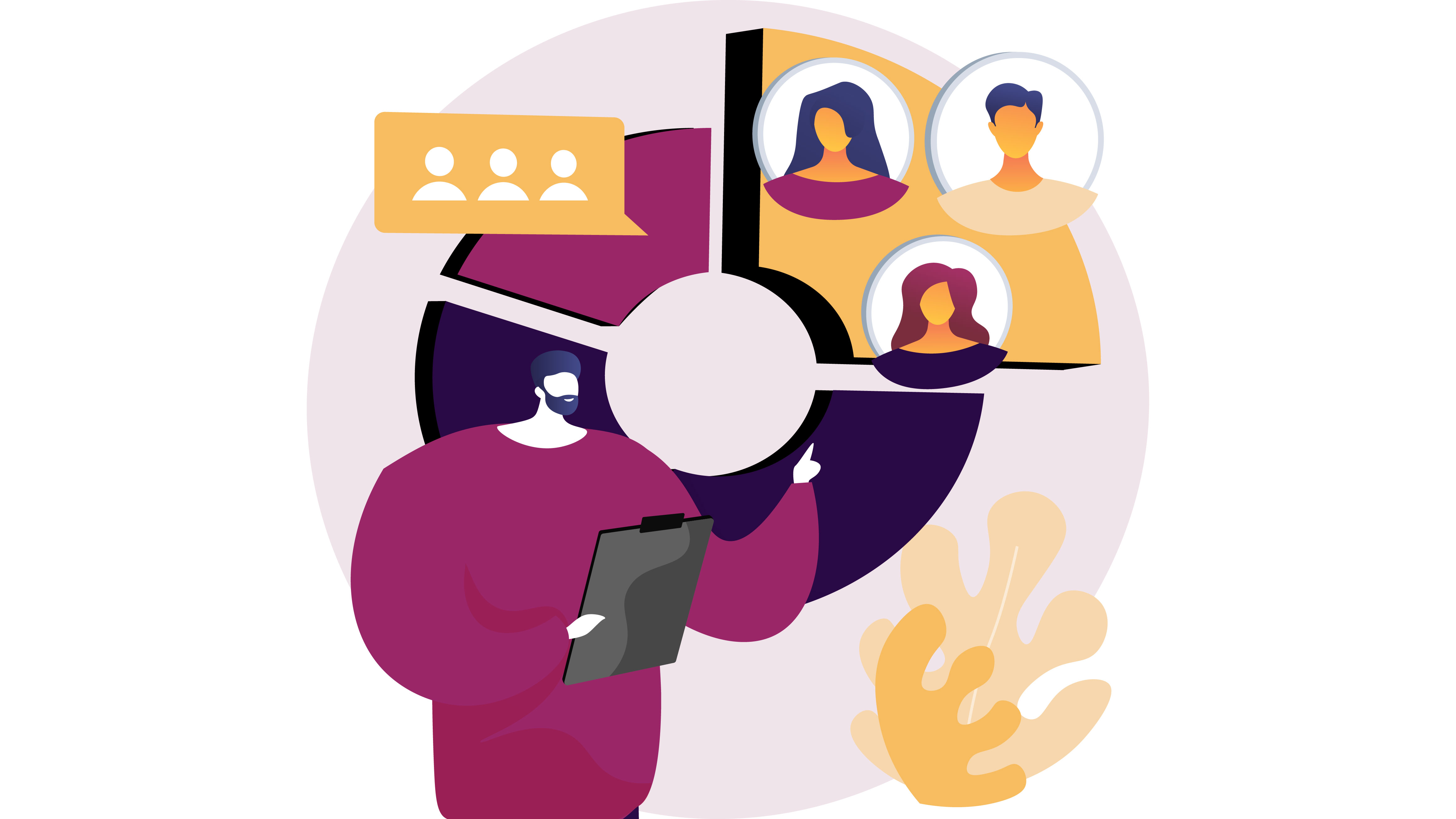
What Is Audience Segmentation And Why It’s Important?
Consider this: In B2B marketing, you can technically succeed without audience segmentation – true. However, settling for anything less than greatness – in this dynamic sphere dominated by personalization – seems counterintuitive.
Your business outcomes are bound to be far superior when you tap into the power of audience segmentation. Here are some numbers to corroborate our claims:
80% of consumers are likelier to purchase from a brand that provides tailored experiences.
71% of consumers expect companies to deliver personalized interactions, and 76% get upset when custom approaches are not delivered.
Therefore, let's explore audience segmentation in more depth – your professional catalyst – to set you apart in the competitive landscape.
What Is Audience Segmentation in the B2B Market?
Audience segmentation identifies and categorizes a specific group of individuals within a larger target audience – based on shared characteristics or behaviors.
Coined by Wendell R. Smith in 1956, this approach allows you to tailor your marketing efforts and messages to different segments effectively.
Illustration of an Audience Segment
In the context of an ed-tech company, let's consider an example of audience segmentation. Its core demo includes both small private schools and large public universities.
It employs audience segmentation to divide its target market into segments based on relevant criteria:
- Institution size
- Curriculum type
- Tech infrastructure
The company then designs distinct segments and categorizes institutions using a matrix:
| Segment 1: Small Private Schools | Segment 2: Large Public Universities |
| Institution Size: 20-200 students | Institution Size: 2,000-20,000 students |
| Curriculum: General education with an emphasis on liberal arts | Curriculum: Diverse range of academic programs and majors |
| Technical Infrastructure: Basic computer labs and limited online resources | Technical Infrastructure: Extensive IT resources and online learning platforms |
With these segments established, the firm can develop tailored marketing messages and product offerings for each group.
For instance:
- It might highlight small private schools' ease of implementation and cost-effectiveness.
- It might emphasize scalability and integration capabilities for large public universities.
The 5 Pillars of Successful Audience Segmentation
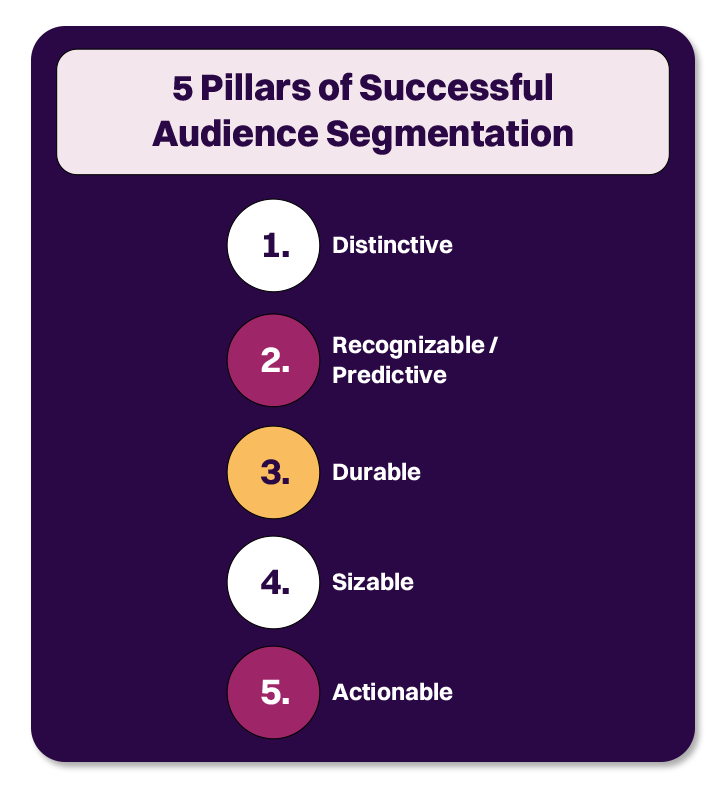
Successful audience segmentation involves five key pillars:
1. Distinctive
If you can't easily articulate the defining characteristics of a segment, then it shouldn't exist. Ensure each segment has unique attributes that can differentiate it from other groups.
2. Recognizable/Predictive
An influential segment should be easily identifiable and predictable. For example, if you need help to place a prospective/existing customer into a specific segment, that segment may not be clearly defined or relevant.
3. Durable
A durable segment remains relevant and meaningful over time. It has a long-term effect and consistently guides you in making strategic decisions.
4. Sizable
Ensure there are enough segments to address diverse customer needs. However, avoid creating excessive segments that give no value. Instead, they may end up draining your resources – since each group requires separate offers and strategies.
Hence, maintain a manageable number of segments for efficient resource allocation.
5. Actionable
Your segments MUST represent viable market opportunities. Only then you can successfully target and engage with them. NOTE: In B2B markets, our experts at Revnew recommend focusing on around 3 to 6 segments.
By incorporating these five pillars into audience segmentation practices, you can ensure your segmentation efforts are:
- Effective
- Strategic
- Impactful
– in driving marketing success and meeting the diverse needs of your customers.
The 10 Types of B2B Audience Segments
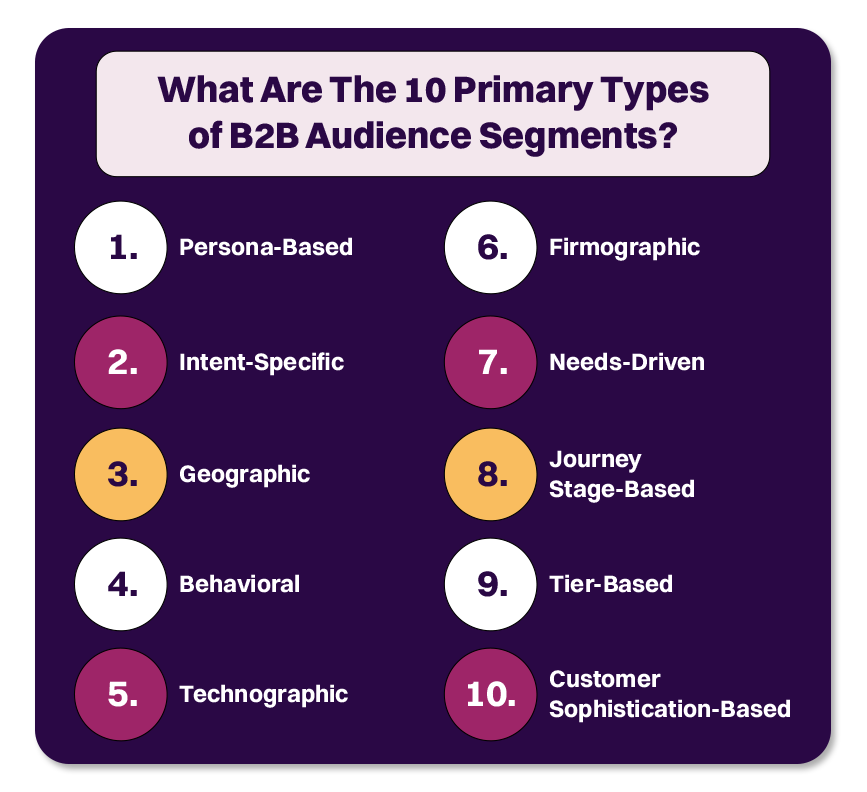
1. Persona-Based
As it's evident from the name, these audience segments comprise specific buyer personas within your B2B market. To create your personas, you can analyze factors such as:
- Job titles
- Industry
- Company name
- Goals
As such, your buyer personas will represent different types of decision-makers or influencers within organizations.
2. Intent-Specific
It categorizes organizations based on their intentions or objectives when interacting with your business.
This segmentation considers different B2B buying process stages, such as:
- Initial research
- Evaluation
- Procurement
- Post-purchase activities
You can align your marketing efforts by understanding the intent behind each stage.
3. Geographic
Geographic segmentation divides organizations based on their geographical location. It considers factors such as:
- Country
- Region
- Industry clusters
As such, you can analyze:
- The unique market conditions
- Cultural differences
- Regulatory frameworks
– of different regions.
Hence, you can consider your customer’s specific geographic segment to customize your marketing strategies and offerings.
4. Behavioral
It groups organizations based on their:
- Behaviors
- Actions
- Engagement patterns
– with your brand.
This segmentation considers factors such as:
- Purchase history
- Engagement with marketing campaigns
- Content consumption
- Interactions with your website or digital platforms
By analyzing these behaviors, you can design targeted campaigns aligned with organizations' unique needs/preferences based on their past actions.
5. Technographic
Technographic segmentation segregates audiences based on the technologies, software, or digital tools they use. It considers factors such as:
- The type of industry-specific software
- The kind of cloud services
- The IT infrastructure
– utilized by organizations.
By understanding the technological landscape of different segments, you can focus on each organization's specific:
- Technological requirements
- Integration capabilities
- Digital transformation needs
– in each technographic segment.
6. Firmographic
It involves categorizing organizations based on firmographic attributes such as:
- Industry
- Company size
- Revenue
- Geographic location
- Organizational structure
Therefore, you can develop targeted marketing strategies that address the:
- Unique challenges
- Industry-specific needs
- Regulatory compliance requirements
– of different types of B2B businesses.
7. Needs-Driven
Needs-driven segmentation focuses on identifying and categorizing organizations based on their specific requirements that your product/service can address.
For example, you may segment organizations based on their:
- Need for enhanced cybersecurity
- Improved operational efficiency
- Better customer relationship management
8. Journey Stage Based
It divides organizations based on their stage in the buyer's journey. The buyer's journey typically involves stages such as:
- Awareness
- Consideration
- Decision-making
- Post-purchase
Once you know where customers are in their buying process, you can deliver targeted, stage-based content and experiences:
For example:
- Organizations in the awareness stage may require educational content to understand their pain points.
- Companies in the decision-making stage may need product comparisons or demos to make a final purchasing decision.
9. Tier-Based
Tier-based segmentation segregates organizations based on their importance or value to your business.
It considers factors such as:
- Revenue potential
- Account size
- Strategic significance of the firm
By assigning different tiers to organizations, you can allocate resources and prioritize your efforts accordingly.
For instance:
- High-value tier 1 accounts may receive personalized account management and tailored marketing campaigns.
- Tier 3 accounts may receive more standardized communication.
10. Customer Sophistication Based
It classifies organizations based on their:
- Knowledge and expertise
- Years of operation
- Sophistication level
– within your industry.
This segmentation considers factors such as your customers’:
- Familiarity with your product or service category
- Understanding of industry trends
- Level of expertise in the domain
When you segment organizations per their sophistication levels, you can avoid either oversimplifying or overwhelming them with information.
For example:
- You may develop content and campaigns that are more educational and introductory for less sophisticated customers.
- You can offer advanced insights and thought leadership content to more sophisticated customers seeking in-depth industry knowledge.
What’s the Importance of B2B Audience Segmentation?
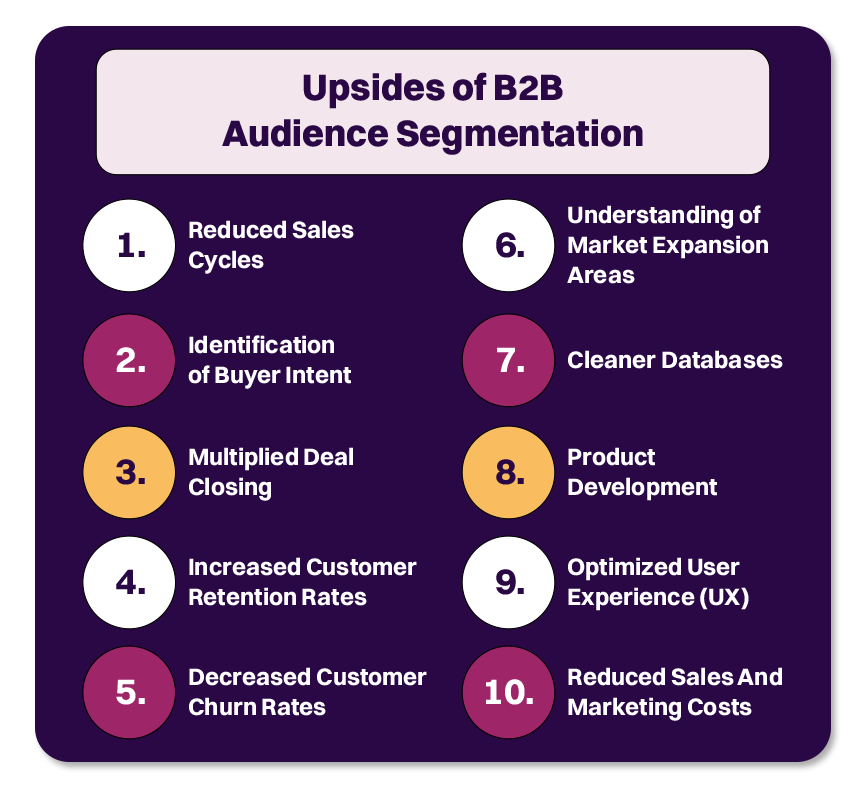
Mailchimp's research shows segmented campaigns perform significantly better than their non-segmented counterparts. The average performance of these campaigns is highlighted across various metrics, such as:
| Campaign Metric | Average Performance |
| Opens | 14.31% higher than non-segmented campaigns |
| Unique Opens | 10.64% higher than non-segmented campaigns |
| Clicks | 100.95% higher than non-segmented campaigns |
| Bounces | 4.65% lower than non-segmented campaigns |
| Abuse Reports | 3.90% lower than non-segmented campaigns |
| Unsubs | 9.37% lower than non-segmented campaigns |
Now that the numbers have spoken, let’s check out the benefits of B2B audience segmentation in detail:
1. Reduced Sales Cycles
When you break down your B2B audience into different segments, you really get to know their specific needs and what they're struggling with.
It enables you to create messages and solutions that speak their language. Hence, customers start to see you as a reliable partner. Therefore, this trust helps in closing your sales faster.
2. Identification of Buyer Intent
Segmentation helps determine which organizations are looking for what. It means you deliver precisely the correct and relevant information per your buyer's specific intentions or objectives.
3. Multiplied Deal Closing
Having custom messages that fit each segment makes closing deals much easier. You can adjust your approach to match precisely what they're looking for.
4. Increased Customer Retention Rates
Your personalized approaches make customers feel that they're your center of focus. Such targeted attention increases customer retention and loyalty.
5. Decreased Customer Churn Rates
By understanding what's bothering your audience and solving those issues, you build trust and long-lasting relationships. When customers feel understood and supported, they don't leave as easily.
6. Understanding of Market Expansion Areas
Breaking down your audience into segments shows you places where you can expand your market. Studying how different groups behave gives you new chances to grow.
7. Cleaner Databases
Sorting your audience into segments helps you keep your customer info neat and tidy. This means you can easily find the right details for targeted campaigns and analyzing data.
8. Product Development
Audience segmentation gives you insights into what different groups of customers really want. This knowledge helps you make better products that match their needs.
9. Optimized User Experience (UX)
A user-friendly experience means giving people what they're actually interested in. When you design things this way for each segment, people engage more and enjoy it.
10. Reduced Sales and Marketing Costs
Focusing on specific segments lets you use your budget more wisely. You're not wasting resources on the wrong leads or messages that don't matter. This way, you run sales and marketing more efficiently and cut costs.
How to Segment Your B2B Audience: A 10-Step Framework
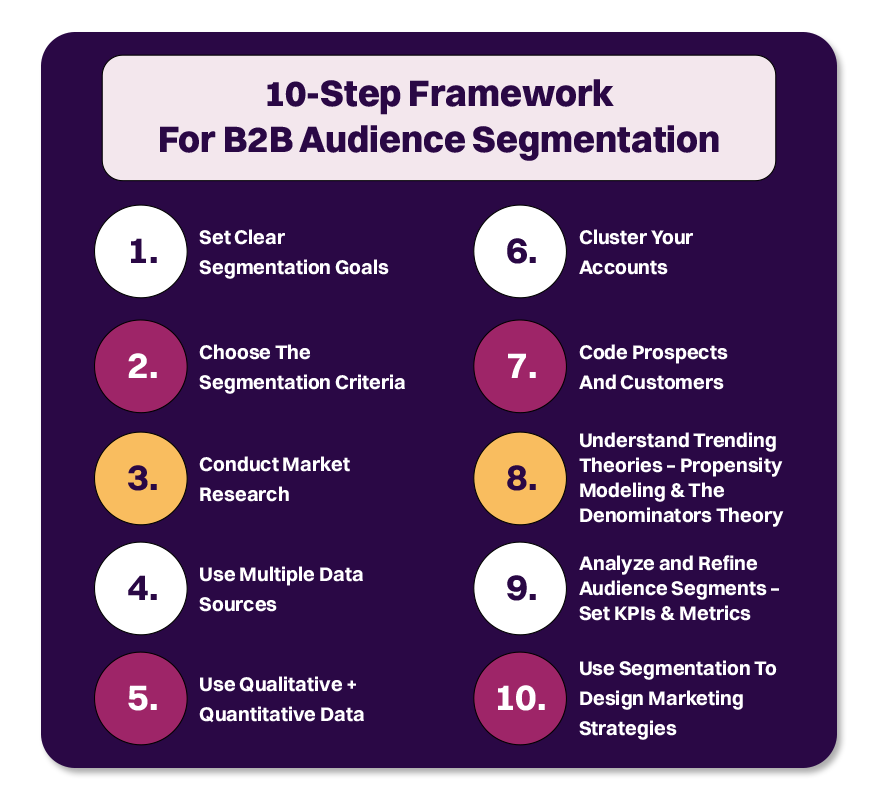
1. Set Clear Segmentation Goals
Clarify the specific outcomes you aim to achieve through audience segmentation.
For example, your goals may include:
- Improving targeting efficiency
- Increasing customer engagement
- Diving higher conversion rates
Setting clear targets can align your segmentation strategy with your overall business and marketing objectives.
2. Choose the Segmentation Criteria
Next, select the specific factors or variables you will use to divide your B2B audience into distinct groups. These criteria can be:
- Demographic
- Firmographic
- Psychographic
- Behavioral attributes
Examples of segmentation criteria include:
- Industry
- Company size
- Geographic location
- Buyer intent
- Customer behavior
- Consumer needs
Selecting the proper criteria is crucial to ensure the resulting segments are meaningful and relevant to your business.
3. Conduct Market Research
Market research is vital in informing your segmentation strategy. It involves gathering relevant data and insights about your:
- Target market
- Competitive landscape
- Customer preferences
Market research methods can include:
- Surveys
- Interviews
- Focus groups
- Analysis of industry reports
4. Use Multiple Data Sources
To obtain a comprehensive view of your B2B audience, you should leverage multiple data sources – internal and external.
Internal data sources may include:
- CRM data
- Website analytics
- Customer surveys
- Transaction history
External data sources may encompass:
- Market research reports
- Industry databases
- 3rd-party data
5. Use Qualitative + Quantitative Data
Qualitative data gives you insights into customer motivations, pain points, and preferences. You can gain this understanding through interviews, focus groups, and customer feedback.
Quantitative data, on the other hand, offers statistical analysis and trends through numerical data. It enables you to recognize similarities and patterns – for making wise choices.
Combining qualitative and quantitative data gives you a more robust audience understanding.
6. Cluster Your Accounts
Once you have gathered data and identified your segmentation criteria, the next step is to cluster your accounts. Clustering involves grouping similar accounts or organizations based on your chosen segmentation criteria.
This process helps to identify commonalities and patterns among accounts. As such, it enables you to create distinct segments with shared characteristics.
7. Code Prospects and Customers
After clustering your accounts, assign segment codes or labels to prospects and customers – based on their assigned segment.
This coding helps appropriately categorize and tag individuals within each segment. Therefore, you can track segment-specific interactions, behaviors, and responses.
8. Understand Trending Theories
Two critical theories in audience segmentation are Propensity Modeling and The Denominators Theory.
- Propensity Modeling uses historical data and statistical techniques to predict customer behavior within each segment. It helps you identify patterns and probabilities of future actions. Thus, it promotes more targeted marketing strategies.
- The Denominators Theory suggests considering each segment's size and potential relative to your overall market and business goals.
By understanding these theories, you can make informed decisions and prioritize segments based on their impact and potential.
9. Analyze and Refine Audience Segments
Once you have established your audience segments, you must:
- Continuously analyze their performance
- Refine the segment definitions as needed
It involves monitoring key metrics and evaluating how each segment performs against your defined goals. By analyzing segment performance, you can:
- Identify areas of improvement
- Uncover new insights
- Make data-driven adjustments to your segmentation strategy
Refining segment definitions may involve:
- Adjusting the criteria
- Adding new variables
- Splitting or merging segments based on their effectiveness and relevance
Set KPIs and Metrics
Establish Key Performance Indicators (KPIs) to monitor your segmentation approaches’ progress and success rates.
These KPIs can include:
- Segment growth rate
- Engagement rate
- Conversion rate
- Customer satisfaction score
- Customer lifetime value and more
By setting measurable metrics, you can:
- Assess the impact of your segmentation strategy
- Make informed decisions
- Demonstrate the value of segmentation to stakeholders
10. Use Segmentation to Design Marketing Strategies
With comprehensive audience segmentation, you get a deep understanding of each segment's requirements, preferences, and characteristics. Therefore, you can design custom marketing campaigns that are relevant to your targeted demographic.
It involves creating personalized messaging, content and offers that address each segment's specific pain points and interests.
Audience Segmentation Example with Template
Let’s finally explain B2B audience segmentation with a fictional case study. B2B software giant XYZ Inc focuses on offering productivity solutions to businesses.
| Customer Segmentation Example for A Software Firm - XYZ Inc | |
| Psychographic Segment | Usage-Based Segment |
| Innovators: Innovative companies invest in new technology | Power Users: Customers with a high level of software engagement |
| Efficiency Seekers: Prioritize their workflow | Occasional Users: Rely on essential features and may require periodic re-engagement initiatives |
| Collaboration Champions: Foster partnerships | |
Hone the Audience Segmentation for Your Business Success
As you can see, employing audience segmentation methods can create targeted strategies that enhance customer satisfaction and loyalty and drive growth.
Ready to unlock the potential of customer segmentation for your business? Connect with Revnew today and discover how our segmentation strategies and data analytics expertise can help you optimize your marketing efforts, drive customer engagement, and achieve business success. Contact us now for a personalized consultation.
